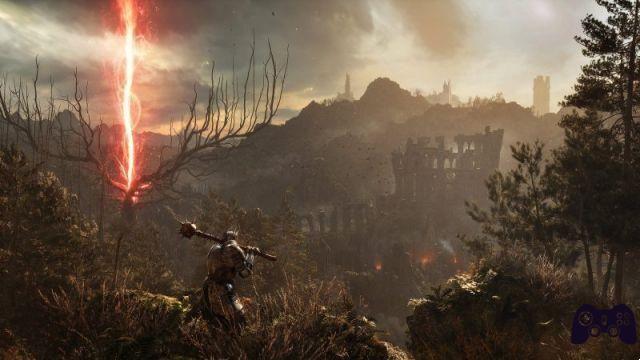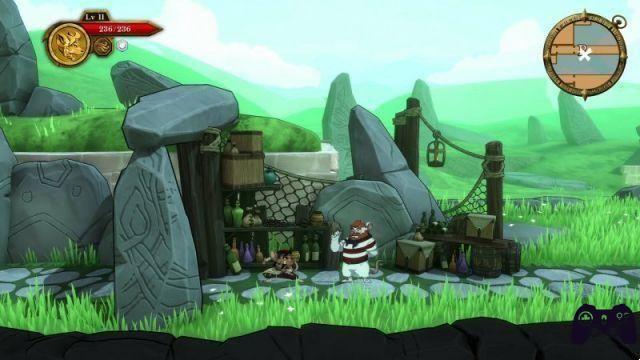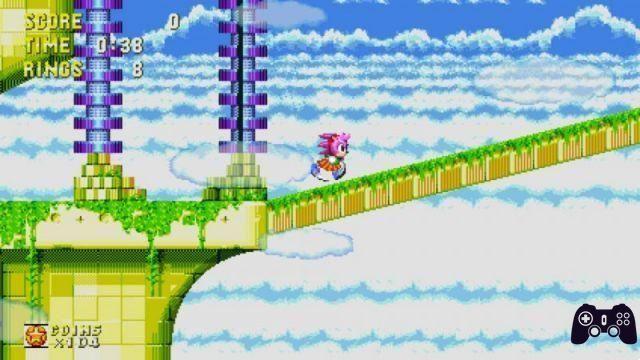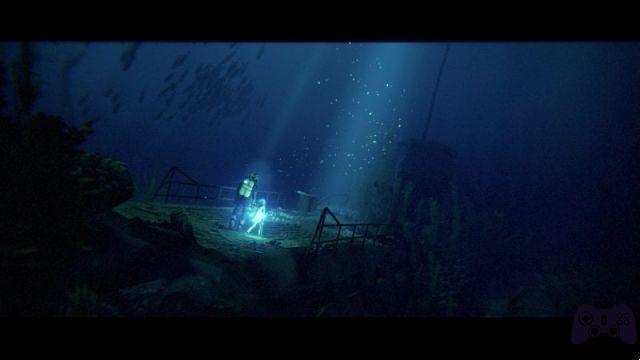It is a question that has been on our minds for years and that comes back strongly with each new announcement of a title of this type, but we still have not been able to understand why so many developers are dedicated to the soulslike genre. "Popularity and easy sale", you could say, but outside of FromSoftware's work there are not many emulators that have achieved success, not to mention that even the most popular cases (like Nioh, for example) have tended to stand out more for its unique characteristics than for its proximity to the works of Miyazaki and company.
Therefore, in our opinion, there are only two possible answers: either the aforementioned software houses are underestimating the complexity of this curious and now very famous mutation of action role-playing games, convinced for some strange reason that it is more easier to handle than other genres, or among are true lovers of FromSoftware's works, who have carefully studied each element of them and to date are sure of being able to create something at least comparable.
While it may seem a bit arrogant to think that you can borrow the success of such an established team from the ground up, recent events tip the balance more towards well-prepared work than reckless work; The recent Lies of P, for example, demonstrated how, by properly tweaking the foundations already seen and supporting everything with the right level of development expertise, it is possible to create a game truly worthy of attention and support. This Korean-made exploit would be enough to strengthen the above theory, however, this year there is another high-end production that has stood out, namely Lords of the Fallen which brings to life one of the first non-Soulslikes. FromSoftware and were never released. and, unlike his rival just mentioned, he gives the impression of wanting to take many risks to distinguish himself from his "muses."
We analyzed it, getting lost for hours in its labyrinthine maps (literally, our sense of direction leaves little to be desired), and believe us when we tell you that this was not a review easy. Yes, because the new Lords of the Fallen by Hexworks is a unique soulslike, to say the least., which at times was able to impress us more than any other exponent of the genre, and disappoint and irritate us at levels never seen before.
Narrative: There are no wishes in this lantern.

Although the absence of numbers in the title and the new team at the helm of the project may suggest a complete reboot of the saga, Lords of the Fallen It is in all respects a direct sequel to the game of the same name. Eons passed after the raids of the tattooed Harkyn. At least the Hexworks writers have reworked the events in a fairly simple way, to offer a new starting point that, at least in part, allows newcomers to enjoy the story without having to remember who knows what connections to the first game. After all, the basis remains the same: we are still in place of mourning, a kingdom that has always been threatened by the fearsome demon god Adyr who, after years of peace under the guidance of the heroes who sealed it in the past, now faces a dark period once again. The pillars of light that contained the evil entity are now corrupted, Adyr is close to resurrection, and humanity is cornered, engulfed by unstoppable waves of violence. To restore peace, faith in the god of light Orius no longer seems to be enough, so his devotees are forced to rely on the blasphemous power of a mysterious lantern. The bearers of this artifact can also always pass freely from the world of the living to the world of the dead and be reborn if they die: abilities far from the sacred light that the sentinels of Orius refer to, but perhaps the only way to stop it. a seemingly unbeatable evil deity.

It is certainly not an original premise, but it serves its purpose and, as is typical of the genre, hides countless unexpected secrets. Hexworks, for its part, has clearly done its best to create a fascinating world where morality is extremely relative and the characters encountered are well-characterized enough to enrich the events, but if you think you can understand each event without problems... Well, you run the risk of being very disappointed: Lords of the Fallen relies heavily on FromSoftware when it comes to narrative and therefore gameplay. very rarely will it be clearly explained to you what is happening with intermediate scenes. No, the team has scattered ghostly echoes across the maps that partially tell the stories of the places and inhabitants of Mournstead, and you'll have to work hard to piece the puzzle together. Not only that, most main quests involving non-player characters require precise items and actions that, if lost, make certain subplots break easily. Considering the overall complexity of this universe, we've found certain connections even darker than those seen in Miyazaki's early Souls, and we have no doubt that it will take time to fully untangle the skein.
However, in our opinion, this is a pretty smart choice: the game offers a lot of interesting content and narrative ideas, and it has already been shown several times in the past how a similar narrative structure can go a long way in creating a passionate community. . . However, whether you're a fan of the choice made or not, this is certainly not the only lesson Hexworks has learned from FromSoftware, as we'll see shortly.
Lords of the Fallen Gameplay: Remember to Dodge

First, however, it's time to talk about the gameplay, because Lords of the Fallen is, as always, a mix of already seen mechanics, but the spices added by the developers gave the minestrone a more unique flavor than we expected. At its base is a system linked to a combination of extremely variable constructions, with a great variety of weapons - they have separate sets of moves depending on type, but there are still a lot of them, and the speed varies from weapon to weapon - and a curious emphasis on abilities to deal damage at a distance. The new Lords of the Fallen offers a large number of thrown objects, bows and crossbows, and to all this it also adds three quite powerful schools of magic. For God's sake, said like that it may seem like something insignificant and very common in the genre, but the difference here is the flexibility of these tools: whether throwing projectiles or spells, the player can equip three at a time (or even more thanks to certain items) and it's very easy to get consumable ammo for ranged weapons or mana crystals for spells. This focus on ranged weapons has led Hexworks to make some obvious balancing errors in enemy management, but overall battles are enriched and offer less "straightforward" approaches even for those who typically devote little to the arcane arts. .

Dal canto suo, hand to hand combat It's not bad at all and it has a movement speed much higher than what other soulslikes are used to. In fact, your alter ego is capable of running at high speeds with relatively little stamina consumption, and his dodge (when the target is active) is a sudden dash that feels a lot like the one in Bloodborne, albeit with a window of greater invulnerability. The effectiveness of dodging makes it the most useful defensive maneuver in the game, but the developers have decided to increase the overall complexity a bit and also offer a parry system directly connected to an increasingly present stun bar.
In the new Lords of the Fallen there is no possibility of using the classic executions from behind, to deliver a fearsome final blow to the opponent you must first stun him and the quickest way to do this is to make a series of perfect parries. There is only one small problem: the shields and weapons here only partially protect against attacks and if you defend yourself against enemies in this way you not only consume a large amount of stamina, but also suffer "temporary damage" that can only be recovered. attacking. On paper, being able to regenerate hit points lost when parrying may make parrying seem preferable to dodging, however some elements of balance make the maneuver extremely risky, such as the fact that Basic enemies do really over the top damage., or have temporary damage immediately convert to real damage as soon as you fail. Since the defensive window for making perfect saves is short, in a game where immediate death can depend on even small errors, this maneuver becomes the domain of only a small circle of players. It is probably also for this reason that death, in Lords of the Fallen, does not represent an immediate return to the last checkpoint.

The fulcrum of the experience and the most original element of the title continues to be the presence of one alternate dimension called Threshold, a kind of afterlife that intersects with the real world, transforming maps and significantly amplifying threats that are no longer underestimable. When you die you immediately reappear in the Threshold version of the place you were, with a life point bar consumed by partial damage (rechargeable with attacks such as the one suffered when parrying), transformed parts of the map, additional enemies and a dangerous timer. always active. In practice, the existence of Threshold makes death less punishing than in most soulslikes, because, even once severely destroyed, the player has the chance to avoid enemies, recover lost hit points, and return to the "world." real" using effigies that are usually quite numerous; Unfortunately, however, perhaps to prevent the transition from one dimension to another from being too exploitable by players, Hexworks has approached the difficulty in a... rather absurd way.
Negative elements and progression: a thousand ways to die badly

To explain in detail why we believe that the difficulty progression is generally miscalculated, it is best to start from the basics of soulslike, also giving some healthy examples. FromSoftware's games, for example, are certainly not monolithic bastions of good balance, and even among their maps over the years there have appeared options capable of making us shout a loud "Miyazaki why" to the heavens, commonly accompanied by the name of some saint. adds color to everything. That said, enemy placement and difficulty progression are much smarter in the Japanese studio's works than most players realize.
Let's get into the details: in each soulslike, FromSoftware designers build the world taking into account the player's progression based on possible "paths", and commonly calculate the strength of enemies, their number and positioning based on the main paths they They hope to continue. by most people during the campaign. The game allows you to deviate from this basic progression in many ways, but if you decide to go off course, it either puts you in increasing danger or discourages less skilled players with particularly brutal elite units placed like blocks at some junction where it is not. possible. It is advisable to enter during the first steps. They are obvious design solutions, but their careful application is by no means easy, and part of the reason why most experts consider FromSoftware titles excellent is precisely the excellent balance achieved, which is certainly not enough to make some choices perverse ones break. Well, now try to imagine what the first Dark Souls would be like if, instead of placing the black knights or the fearsome silver archers in well-defined areas, FromSoftware had stuck them almost everywhere, constantly surrounding them with normal monsters and making sure to make them increasingly stronger and more aggressive from one area to another. It's not very nice, is it? Good, because Lords of the Fallen is literally balanced like this on three-quarters of the maps.

Hexworks' solution to the "second chance" advantage offered by Umbral was, simply, filling each map with the most irritating units imaginable by the human mind, as well as an excessive number of infamous ways to die. Once past the first areas, practically every new location contains some type of long-range unit, capable of reaching the player at Olympic distances and with enviable precision. As if that were not enough, it very often happens that we find Mini bosses that transform into elite units directly in the same area where you fought them the first time. - happens often in the genre, but usually after a few hours, not on the same damn map - almost always surrounded by a myriad of very annoying minor monsters and the friendly snipers I just mentioned. Added to these wonders is the fact that all these units are capable of killing you with one or two hits at most (investing in life points and heavy armor offers truly ridiculous protection) and that in the game there are also pleasant surprises such as invisible imitations which can kill you instantly or transport you to Threshold, explosive monsters hidden on rooftops and other cheerful conveniences, and you'll face the most annoying and miscalculated basic enemies in the history of the genre.
At least, Balance errors are two sides of the same coin., and this means one very simple thing: just as the opponents are disgustingly over-the-top, the player can also become an unstoppable force of nature by taking advantage of the system that Hexworks offers. Flashlight, for example, can stun enemies, cause serious temporary damage, and throw them off cliffs if you "reposition" their soul after ripping it from their body; The aforementioned ranged weapons and magic have impressive range and accuracy, allowing you to tactically take out some of the most dangerous targets before being surrounded, and the running speed most of the time allows you to get out of trouble without a problem. ; However, even considering these factors, we find that the game's bosses are significantly better calculated than simple mobs, and the decisions made by Hexworks in the progression and positioning of enemies are still really dumb, to the point of partially ruining one. of the best elements of the game. : exploration.
This gets even worse when you go to Threshold: in the afterlife, in fact, not only are there additional units that are sometimes extremely dangerous, but they also have to be taken into account. a timer which, although permissive, continues to make enemies of increasing difficulty appear - first insignificant zombies, then monstrosities equipped with bullets or very fast attacks - and which, taken to the limit, evokes a kind of grim reaper capable of killing you instantly. It is less serious than what was done previously, also because of the aforementioned effigies that allow you to return to the normal dimension, but keep in mind that in Lords of the Fallen the passage to the afterlife is not optional, because the structures present there are essential for be able to progress.
Positive elements and structure: passed with the highest score in the spiral university

Problems like those just mentioned can discourage most people, and we are fully aware of their seriousness. However, Hexworks' work still manages to clearly surpass sufficiency despite its shortcomings, elevated mainly by a single element: Top-notch design, far exceeding our wildest expectations. When we had the opportunity to interview the developers, they told us that the maps would be the fulcrum of the experience and that it was the first element designed by the team, around which everything else was built. Well, we assure you that you can see it, just as you can clearly see that the designers of the software house have he studied almost religiously the extraordinary spiral map of the first Dark Souls, as Mournstead reworks the concept in some really interesting ways.
In practice, just as Miyazaki's masterpiece boasted a perfectly interconnected world, where each setting was connected in an absolutely brilliant way, so in Lords of the Fallen you will reach places already visited after having traveled kilometers and having opened unthinkable shortcuts, plus almost all beautifully connected to a useful main hub. The work done is often impressive and is further enriched by the possibility of entering the Threshold dimension at will (you can also do it actively with the flashlight, you don't necessarily have to die), which often hides passages, weapons and hidden objects.

Threshold doesn't offer any real alternate maps, but the layering of the game world is such that if it had, things might have been overly complicated. That the afterlife is in most cases an obligatory passage makes more sense than ever, and the streets and stairs that appear only when you enter them even offer simple but interesting environmental puzzles, capable of breaking gracefully from the ranks of the genre. . Virtually every area offers some kind of secret if explored in its "parallel" version, further rewarding those who decide to examine every corner; If it weren't for the very annoying enemies that constantly use you for skeet shooting, Hexworks' Soulslike would be among the most enjoyable to review.
For the record, this team learned the lessons of FromSoftware in their purest form: Don't expect today's facilities. o a clear linearity in the main path: the campaign revolves around the purification (or not) of various pillars of light sometimes even reachable in no particular order (we, for example, have completed a couple of advanced areas before a much more manageable map). ), the player is not held by the hand during progression, and the only clue offered are drawings that roughly indicate the direction to follow to achieve the main objectives. Pay attention after you find them, because they often hide excellent tips for reaching key areas. Also, if that wasn't enough, main control points in-game they are rare, to say the least, to the point that you are forced to open alternate passages or use additional sprouts (which can be purchased from a specific vendor in the main hub) to safely approach bosses. A philosophy that is very close to the precursors of the genre.

Sincerely? We really like a similar stance regarding the exploratory element. It is true that, on the one hand, we love the evolutions and increased accessibility that soulslikes have experienced, but a part of us has been waiting for a title of this type for a long time, capable of making us lose ourselves in its ins and outs and trap us. us with our guard down. It's a real shame that so much goodness is ruined by the serious balance issues described above, because if it had been managed more sensibly it would have had all the qualities to excel in our opinion.
It is difficult, then, not to praise boss battles. Having eliminated some difficulty spikes that in this case were also a little out of place, the developers managed to create really exciting and varied confrontations, often able to creatively exploit the transition to Threshold (although the variations on the theme in this case are not many). . It is really incomprehensible how a team capable of creating similar opponents has fallen so badly precisely in mob management.
Technical sector: in the unreal labyrinth

Interestingly, despite the proclaimed power of Unreal 5's engine, Lords of the Fallen is also a mixed bag from a technical point of view. The level of detail in the maps is truly remarkable, and the game offers stunning views, as well as a wide variety of environments, weapons and armor. Unfortunately, the quality of certain animations or human faces is not at the same level - starting with a character editor whose handling is complicated to say the least - and during the review we also had to deal with some serious optimization problems, in addition to others that were an oversight. technical.
The first issue has already been partially resolved with a couple of patches, and areas that were previously even more frustrating with unwarranted freezes and serious framerate drops are now completely stable (although it still happens that you see strange performance drops) . certain situations); The bugs are a bit minor, and the fact that Epic's engine is still in its infancy in terms of blockbusters seems pretty clear. It happened to us several times to see enemies trapped in one or another element of the landscape (or get stuck by an unexpected movement); Although rarely, it happened that the game did not detect some attacks, recorded the damage dealt in a somewhat haphazard manner or caused our projectiles to end up against invisible walls, and the enemy artificial intelligence, no matter how aggressive, often demonstrated the tendency to partially reset . In short, a long list of small problems, which demonstrates the team's lack of experience in using the tools offered and time to optimize them. Overall, though, considering Lords of the Fallen is one of the first projects of this scale to use Unreal 5, we still have to congratulate Hexworks for producing a stable and functional overall game. It was not a fact at all.

The sound is not so good: the soundtrack is certainly not memorable, while the dubbing and effects often made us turn our noses. Things have improved a lot since the disastrous situation of the first versions tested, but we are not there yet. Really excellent, though. longevity- It should take a fairly expert user between 30 and 40 hours to finish everything (mainly depends on how long you decide to continue ignoring the optional contents); We would have liked to explore the multiplayer mode further, but unfortunately it was not possible to delve into it properly during the review. The truth is that, with a friend, the game is infinitely more enjoyable. Oh, finally, the management of the new game+ is also interesting: when facing the campaign again you will be able to use only the main control point in the center, and only use the temporary ones to advance: a trick that makes the map excellent. The design shines even brighter, but makes the experience even more barbaric and punitive. We imagine that many veterans will appreciate it.
Conclusions
Tested version PC with Windows digital delivery Steam, epic games store Price 59,99 € Holygamerz.com 7.0 Readers (55) 7.6 your voteLords of the Fallen will undoubtedly be one of the most divisive soulslikes of all time. On the one hand, Hexworks has produced a brilliant spiritual successor to the first Dark Souls, bolstered by brilliant map design and excellent ideas tied to the exploratory element; On the other hand, the team seriously stumbled in the difficult management of enemy progression and balance, partially compromising the best features of the production. A shame, because even though its flaws are serious, this game really has a unique soul and we believe it has what it takes to win over a passionate community. However, with a little more time and a little reconsideration, it could have reached other heights.
PRO
- Excellent map design
- Varied and quite successful combat system.
- Extremely detailed environments
AGAINST
- Incorrect progression and difficulty balance.
- Exploration partially ruined by enemy location and Threshold timer
- Various bugs and less than stellar optimization on PC






